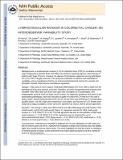Lymphovascular Invasion in Colorectal Cancer: An Interobserver Variability Study

View/
Author
Harris, Elizabeth I.
Lewin, David N.
Wang, Hanlin L.
Shyr, Yu
Shakhtour, Bashar
Revetta, Frank
Washington, Mary K.
Published Version
https://doi.org/10.1097/PAS.0b013e3181816083Metadata
Show full item recordCitation
Harris, Elizabeth I., David N. Lewin, Hanlin L. Wang, Gregory Y. Lauwers, Amitabh Srivastava, Yu Shyr, Bashar Shakhtour, Frank Revetta, and Mary K. Washington. 2008. Lymphovascular invasion in colorectal cancer: an interobserver variability study. The American Journal of Surgical Pathology 32(12): 1816–1821.Abstract
Background: Lymphovascular invasion (LVI) in colorectal cancer (CRC) is considered a strong stage-independent prognostic factor and influences decisions regarding adjuvant chemotherapy in patients with Stage II tumors. However, the degree of interobserver agreement among pathologists for LVI in CRC is largely unknown. This study was undertaken to examine such interobserver variability, and we hypothesized that the use of immunohistochemical markers for vascular and lymphatic channels could improve interobserver agreement. Design: Fifty cases of AJCC stage II moderately differentiated CRC from 1990 to 2005 from the pathology archives were selected; mucinous, medullary, and other recognized special subtypes were excluded. Fifty H&E slides (one from each case) were circulated to 6 GI pathologists, who independently assessed small and large vessel invasion. No diagnostic guidelines were given to the participating pathologists; each was instructed to apply the criteria for LVI that he or she used in daily practice. Immunohistochemistry (IHC) for D2-40 and CD31 was performed on corresponding paraffin blocks. The IHC slides were randomized, recirculated, and rescored for LVI. Results were analyzed by kappa (κ)statistics, which correct for agreement by chance, and for percent agreement. Results: The average κ values were determined for the H&E slides (large and small vessel), CD31 (small vessel), and D2-40 (small vessel) (Figure 1). Agreement was fair for H&E small vessel invasion (κ = 0.28; 95%CI 0.22–0.34). The least agreement was seen in interpretation of H&E large vessel invasion (κ = 0.18; 95%CI 0.11–0.26). Agreement was not improved by use of immunohistochemical stains: CD31 (large vessel, κ = 0.42, 95%CI 0.20–0.63, small vessel, κ = 0.26, 95%CI 0.10–0.42) and D2-40 (κ = 0.32, 95%CI 0.21–0.42). Conclusions: Interobserver variability in diagnosis of LVI was substantial on H&E slides and did not improve upon use of IHC. Agreement in evaluation of large vessel invasion was only slightly higher than would be seen by chance alone. This study highlights the need for criteria in evaluation of lymphovascular invasion, as this assessment may impact patient prognosis and thus change the course of clinical treatment.Terms of Use
This article is made available under the terms and conditions applicable to Other Posted Material, as set forth at http://nrs.harvard.edu/urn-3:HUL.InstRepos:dash.current.terms-of-use#LAACitable link to this page
http://nrs.harvard.edu/urn-3:HUL.InstRepos:12601534
Collections
- HMS Scholarly Articles [17922]
Contact administrator regarding this item (to report mistakes or request changes)


